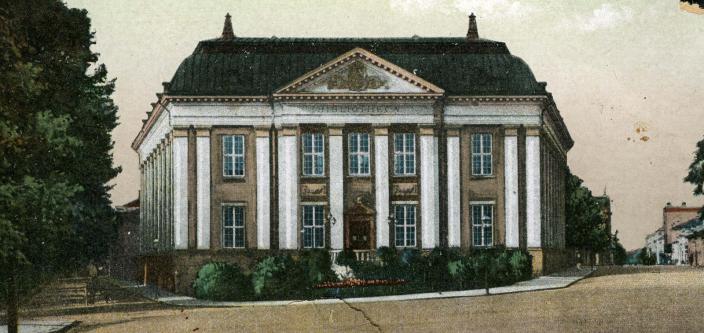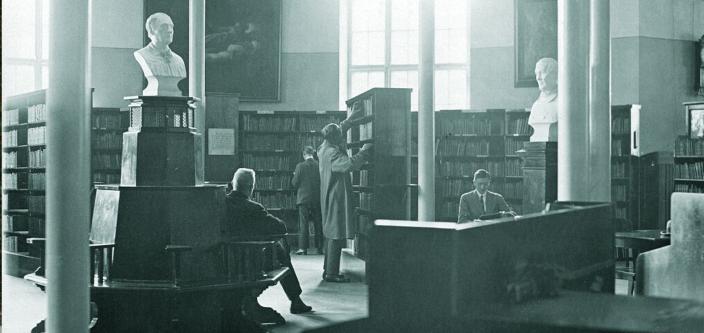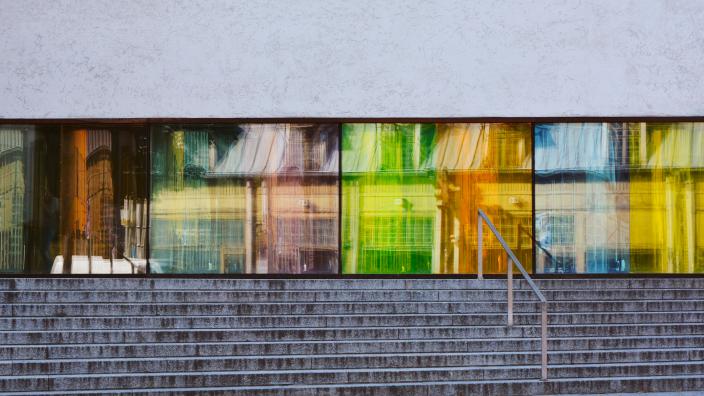The Turku City Library originated from the People's Library and the City Library, which were founded in the 1860s with private funds, inspired by the idea of civic education.
The beginning of Turku City Library
At the end of December 1862, an announcement was published in the Åbo Underrättelser newspaper: 'The local People's Library is open to borrowers on Sundays from 5 to 6 p.m. and Wednesdays from 3 to 4 p.m. at the factory owner Mrs. Alfthán's house along Jokikatu.'
The library initially had 700 books in Swedish and 450 in Finnish. Lending was free of charge, but those who wished could support the library's activities by paying an annual fee of one markka. According to the rules, each borrower was allowed to borrow one book at a time. In the early days, the library had to move several times. The scarcity of funds put the public library under strain, and it was even suspended in the early 1870s. In 1878, the library was taken over by the city and granted an appropriation from the profits of the public house.
After the university moved to Helsinki after the fire, there was no scientific library in Turku. In 1869, the public library was joined by a scientific city library for the educated classes. The city library grew thanks to generous donations. It was also unable to operate with private funds, and in 1891 the city council took over responsibility for its operation.
In 1912, the City Library and the People's Library were merged in name, and the official name became the Turku City Library. The former City Library became the Study Department and the People's Library the General Department. The old collection of the City Library was never merged into a common collection. It still exists as a separate collection.
Fredric von Rettig donated the library building
Turku received its first library building as a donation. Fredric von Rettig handed over the library building he had built to the city council on 17 September 1903. The Bibliotheca, designed by Karl August Wrede, is in the Dutch late Renaissance style and is modelled on the House of Nobility in Stockholm. On the first floor was the People's Library for the working classes and on the second floor the more scientific City Library for the educated classes. The City Library was entered through the main door and the People's Library through the side door on Linnankatu.
Rettig was socially aware, a lover of culture and a supporter of civic education.
Rettig was socially aware, a friend of culture and a supporter of popular education. He was a city councilor and a member of the board of both libraries. In addition to the library building, he donated a collection of 10 000 books, a large sum of money and a valuable art collection to the city.
1910s to 1970s
Radical reforms of the 1910s
Library doctrine was sought from abroad. Einar Holmberg visited England and the United States in the 1910s, bringing with him the American idea of the library as open to all.
This included free home loans for all, open shelves, children's sections, long opening hours and modern classification and cataloguing systems. Inspired by the American library ethos, Holmberg reformed the Turku City Library. He transferred these approaches not only to Turku but also to other parts of Finland.
The ten-year-old library building was beautiful but impractical. The renovation work designed by Holmberg was completed in January 1914, and the most striking feature was the open shelving system, which Turku was the second in Finland, after Porvoo, to introduce. The entrance to Linnankatu was closed, and from then on everyone entered the library through the same door.
The number of borrowers and loans increased many times over. The boom did not last long, as the times ahead were turbulent in society. When Volter Kilpi started as librarian after the civil war in 1919, he found the library in a state of decline. Funds for acquiring materials had dwindled and lending had begun to decline. Kilpi successfully revived the library's finances, but soon moved on to become a university librarian.
Expanding and diversifying its activities
Until the 1910s, the main borrowers from the public library were Finnish-speaking workers, servants and their children. In the late 1910s the borrower base expanded and the library began to move towards becoming a public library. Holmberg reformed the library's rules of use so that everyone in Turku had the right to borrow and borrowing was free of charge.
Turku City Library was also a pioneer in developing customer advising.
Turku City Library was also a pioneer in developing customer advising. Alice Cronvall, the library's deputy director, visited Stockholm in 1933 to learn about the library's advice work and the very next year a 'special table for advice' was set up in the library.
Finland's first newspaper reading room started operating in Turku as early as 1847, run by the Reading Society. When the city took over the People's Library in 1878, a reading room was also established. The library building initially had a separate reading room for men and women. In 1914, the women's and men's reading rooms were combined and newspapers were mounted on stands, following the American model, and read standing up. In 1907, a side reading room was set up on Sofia Street. At most, there were four newspaper reading rooms in Turku, but their collections were rather small. In April 1990, they were merged with the new newsroom in Julin talo on Eerikinkatu.
Over time, a network of a main library, twelve local libraries, two library vans and four lending stations was established in Turku. Turku's first branch library was established in 1939, when the Kaarina Municipal Library became the Nummi Lending Station. Finland's first library bus started operating in Turku in 1961.
In 1970, a music department with modern listening equipment was opened on the renovated second floor of the main library. A few years later, it moved to the former governor's official residence dating back to 1733.
Children are avid library users
Children were avid borrowers from the very beginning, and the first children's reading room was opened in the new library building in 1903. However, it proved to be very cramped for eager borrowers and the children were given their very own lending section and reading room in the 1914 renovations.
Turku was among the first to organises story hours. The first fairy tale evening was held in the autumn of 1916, when elementary school teacher Juho Piltti read Maria Jotuni's The Black Ox. 400 children were present. Fairy tale classes are still an important part of children's library activities in different parts of the city. They have been joined by book tours, exhibitions and reading campaigns. Children and young people are avid library users and most of them have their own library card.
The first story hour evening was held in autumn 1916.
There were 400 children in the audience.
Due to overcrowding, the children's section moved across the river to the Hjelt house, next to the cultural centre, from 1991 to 2007.
Towards a new library
Over time, the magnificent Bibliotheca became cramped and impractical, with the main library operations having to be dispersed to five different locations across the city. Several alternatives to the space problem were proposed as early as the 1980s. The City Council finally decided in 2003 to build the main library in the current spot and approved the project plan and cost estimate for the new main library building.
The new main library consists of the old library building, the new part and the office building between them, which will form a single library space. It will be designed by architects Asmo Jaaksi, Teemu Kurkela, Samuli Miettinen and Juha Mäki-Jyllilä of the JKMM architectural firm, which won the main library architectural competition in 1998.
Café Sirius, which takes its name from the name of the library block, opened in the old office of the Governor's Office.
The aim was to create a new kind of library for the city's citizens: a functional information Centre and a living work of art, where new and old, future and history, knowledge and imagination, lively activity and stillness meet. This goal was even more than expected, the citizens have embraced the main library.
During 2014-16, six local libraries introduced self-service library services, which immediately boosted both visits and loans.




